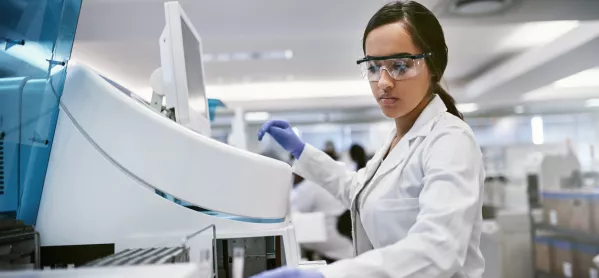Exam boards say their use of positive female role models in A-level science syllabuses has helped to boost the number of girls taking the subjects.
This year’s A-level results revealed that participation from girls has overtaken boys in science A levels, with 50.3 per cent of entries coming from female candidates compared with 46.9 per cent last year.
Related: A-level results: Girls tip gender balance in science
A-level results: Girls overtake boys on top grades
Advice: How to help disappointed students
Entries from girls have risen in all three sciences, including in physics, where entries have been male-dominated in the past.
Jill Duffy, chief executive of OCR, said science syllabuses have been revised to highlight the work of notable female scientists throughout history. She said that more visibility of positive female role models in science could have inspired more girls to take up the subjects at A level.
Explaining why more girls chose science subjects this year, she said: “In our A levels we’ve looked at giving positive role models in terms of science - the important people in science.
“So Rosalind Franklin, she was really instrumental in the discovery of DNA, but she wasn’t the one who got all the credit for it.
“You may hear about other people who discovered DNA like [Francis] Crick and [James] Watson, but actually she did a lot of the work. We’re just making it clear there are some really positive role models in science, and making them more obvious when they have been hidden.”
Ms Duffy also attributed a rise in female entries to the long-term work of teachers, subject associations and campaigners in promoting science to girls.
“There’s been a lot of effort over the years to encourage more girls to take science and to get over some of the stereotypes girls might have had about taking science, and we’ve also made the A-level syllabuses more suitable to girls,” she said.
“As the proud mum of two daughters who are scientists, I think it’s absolutely brilliant,” she added.
Ms Duffy said changes to the syllabuses at A level to include more practical experiments in the classroom had also made sciences more “engaging” for both male and female pupils.
Asked whether the reduction in the number of A* grades in the sciences could have been caused by higher numbers of female entries this year, Ms Duffy said the slight drop in A*s was caused by larger cohort sizes - of both male and female pupils - across the three subjects.
Ms Duffy said it was “hypothetical” to speculate whether higher take-up of science among girls could explain the decline of traditionally female-dominated subjects like English literature and the arts.
“It’s great girls are taking more sciences,” she said. “In terms of what subjects girls would have done instead, we haven’t done that analysis.”




